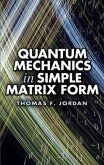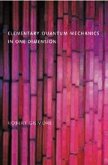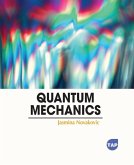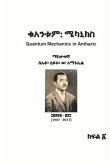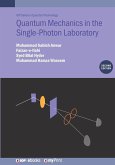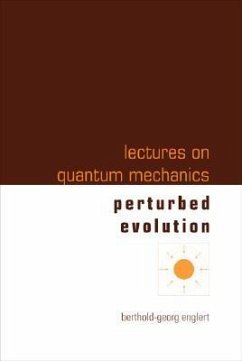Duncan
Constructing Quantum Mechanics 2v Set
Duncan
Constructing Quantum Mechanics 2v Set
- Broschiertes Buch
- Merkliste
- Auf die Merkliste
- Bewerten Bewerten
- Teilen
- Produkt teilen
- Produkterinnerung
- Produkterinnerung
This two-volume book is on the genesis of quantum mechanics. This first volume covers the key developments in the field in the period between 1900-1923. The second volume covers the rapid transition from the old to the new quantum theory in the years 1923-1927.
Andere Kunden interessierten sich auch für
![Quantum Mechanics in Simple Matrix Form Quantum Mechanics in Simple Matrix Form]() Thomas F JordanQuantum Mechanics in Simple Matrix Form13,99 €
Thomas F JordanQuantum Mechanics in Simple Matrix Form13,99 €![Elementary Quantum Mechanics in One Dimension Elementary Quantum Mechanics in One Dimension]() Robert GilmoreElementary Quantum Mechanics in One Dimension33,99 €
Robert GilmoreElementary Quantum Mechanics in One Dimension33,99 €![The Mathematical Principles of Quantum Mechanics The Mathematical Principles of Quantum Mechanics]() Derek F LawdenThe Mathematical Principles of Quantum Mechanics15,99 €
Derek F LawdenThe Mathematical Principles of Quantum Mechanics15,99 €![Quantum Mechanics Quantum Mechanics]() Jasmina NovakovicQuantum Mechanics85,99 €
Jasmina NovakovicQuantum Mechanics85,99 €![Quantum Mechanics in Amharic Quantum Mechanics in Amharic]() Dereje SeifuQuantum Mechanics in Amharic19,99 €
Dereje SeifuQuantum Mechanics in Amharic19,99 €![Quantum Mechanics in the Single-Photon Laboratory (Second Edition) Quantum Mechanics in the Single-Photon Laboratory (Second Edition)]() Muhammad Sabieh AnwarQuantum Mechanics in the Single-Photon Laboratory (Second Edition)28,99 €
Muhammad Sabieh AnwarQuantum Mechanics in the Single-Photon Laboratory (Second Edition)28,99 €![Lectures on Quantum Mechanics - Volume 3: Perturbed Evolution Lectures on Quantum Mechanics - Volume 3: Perturbed Evolution]() Berthold-Georg EnglertLectures on Quantum Mechanics - Volume 3: Perturbed Evolution41,99 €
Berthold-Georg EnglertLectures on Quantum Mechanics - Volume 3: Perturbed Evolution41,99 €-
-
-
This two-volume book is on the genesis of quantum mechanics. This first volume covers the key developments in the field in the period between 1900-1923. The second volume covers the rapid transition from the old to the new quantum theory in the years 1923-1927.
Produktdetails
- Produktdetails
- Verlag: Oxford University Press, USA
- Erscheinungstermin: 20. Oktober 2023
- Englisch
- Abmessung: 299mm x 238mm x 127mm
- Gewicht: 3130g
- ISBN-13: 9780198887034
- ISBN-10: 0198887035
- Artikelnr.: 68053657
- Herstellerkennzeichnung
- Libri GmbH
- Europaallee 1
- 36244 Bad Hersfeld
- gpsr@libri.de
- Verlag: Oxford University Press, USA
- Erscheinungstermin: 20. Oktober 2023
- Englisch
- Abmessung: 299mm x 238mm x 127mm
- Gewicht: 3130g
- ISBN-13: 9780198887034
- ISBN-10: 0198887035
- Artikelnr.: 68053657
- Herstellerkennzeichnung
- Libri GmbH
- Europaallee 1
- 36244 Bad Hersfeld
- gpsr@libri.de
Michel Janssen studied physics and philosophy at the University of Amsterdam and history and philosophy of science at the University of Pittsburgh, where he earned his PhD in 1995. He was an editor at the Einstein Papers Project before joining the School of Physics and Astronomy at the University of Minnesota as a historian of science in 2000. He has also been a regular visitor at the Max Planck Institute for History of Science in Berlin. His research focuses on the genesis of relativity and quantum theory. Anthony Duncan received his PhD in theoretical elementary particle physics in 1975 from the Massachusetts Institute of Technology, under the supervision of Steven Weinberg. Following postdoctoral and junior faculty positions at the Institute for Advanced Study in Princeton and Columbia University in New York, he joined the faculty of the Department of Physics and Astronomy at the University of Pittsburgh in 1981 as Associate Professor of Physics. He has taught a wide range of courses, both at the undergraduate and graduate level, including courses on the history of modern physics. He is now (since 2015) professor emeritus of Physics at the University of Pittsburgh.
* 1: Introduction to Volume One
* I: Early Developments
* 2: Planck, the Second Law, and Black-Body Radiation
* 3: Einstein, Equipartition, Fluctuations, and Quanta
* 4: The Birth of the Bohr Model
* II: The Old Quantum Theory
* 5: Guiding Principles
* 6: Successes
* 7: Failures
* Appendices
* A: Classical Mechanics
* B: Spectroscopy
* Volume II
* 8: Introduction to Volume 2
* III. Transition to the New Quantum Theory
* 9: The Exclusion Principle and Electron Spin
* 10: Dispersion Theory in the Old Quantum Theory
* 11: Heisenberg's Umdeutung paper
* 12: The Consolidation of Matrix Mechanics
* 13: De Broglie's Matter Waves and Einstein's Quantum Theory of the
Ideal Gas
* 14: Schrödinger and Wave Mechanics
* 15: Successes and Failures of the Old Quantum Theory Revisited
* IV. The Formalism of Quantum Mechanics and Its Statistical
Interpretation
* 16: Statistical Interpretation of Matrix and Wave Mechanics
* 17: Von Neumann's Hilbert Space Formalism
* 18: Conclusion: Arch and Scaffold
* Appendices
* C: The Mathematics of Quantum Mechanics
* I: Early Developments
* 2: Planck, the Second Law, and Black-Body Radiation
* 3: Einstein, Equipartition, Fluctuations, and Quanta
* 4: The Birth of the Bohr Model
* II: The Old Quantum Theory
* 5: Guiding Principles
* 6: Successes
* 7: Failures
* Appendices
* A: Classical Mechanics
* B: Spectroscopy
* Volume II
* 8: Introduction to Volume 2
* III. Transition to the New Quantum Theory
* 9: The Exclusion Principle and Electron Spin
* 10: Dispersion Theory in the Old Quantum Theory
* 11: Heisenberg's Umdeutung paper
* 12: The Consolidation of Matrix Mechanics
* 13: De Broglie's Matter Waves and Einstein's Quantum Theory of the
Ideal Gas
* 14: Schrödinger and Wave Mechanics
* 15: Successes and Failures of the Old Quantum Theory Revisited
* IV. The Formalism of Quantum Mechanics and Its Statistical
Interpretation
* 16: Statistical Interpretation of Matrix and Wave Mechanics
* 17: Von Neumann's Hilbert Space Formalism
* 18: Conclusion: Arch and Scaffold
* Appendices
* C: The Mathematics of Quantum Mechanics
* 1: Introduction to Volume One
* I: Early Developments
* 2: Planck, the Second Law, and Black-Body Radiation
* 3: Einstein, Equipartition, Fluctuations, and Quanta
* 4: The Birth of the Bohr Model
* II: The Old Quantum Theory
* 5: Guiding Principles
* 6: Successes
* 7: Failures
* Appendices
* A: Classical Mechanics
* B: Spectroscopy
* Volume II
* 8: Introduction to Volume 2
* III. Transition to the New Quantum Theory
* 9: The Exclusion Principle and Electron Spin
* 10: Dispersion Theory in the Old Quantum Theory
* 11: Heisenberg's Umdeutung paper
* 12: The Consolidation of Matrix Mechanics
* 13: De Broglie's Matter Waves and Einstein's Quantum Theory of the
Ideal Gas
* 14: Schrödinger and Wave Mechanics
* 15: Successes and Failures of the Old Quantum Theory Revisited
* IV. The Formalism of Quantum Mechanics and Its Statistical
Interpretation
* 16: Statistical Interpretation of Matrix and Wave Mechanics
* 17: Von Neumann's Hilbert Space Formalism
* 18: Conclusion: Arch and Scaffold
* Appendices
* C: The Mathematics of Quantum Mechanics
* I: Early Developments
* 2: Planck, the Second Law, and Black-Body Radiation
* 3: Einstein, Equipartition, Fluctuations, and Quanta
* 4: The Birth of the Bohr Model
* II: The Old Quantum Theory
* 5: Guiding Principles
* 6: Successes
* 7: Failures
* Appendices
* A: Classical Mechanics
* B: Spectroscopy
* Volume II
* 8: Introduction to Volume 2
* III. Transition to the New Quantum Theory
* 9: The Exclusion Principle and Electron Spin
* 10: Dispersion Theory in the Old Quantum Theory
* 11: Heisenberg's Umdeutung paper
* 12: The Consolidation of Matrix Mechanics
* 13: De Broglie's Matter Waves and Einstein's Quantum Theory of the
Ideal Gas
* 14: Schrödinger and Wave Mechanics
* 15: Successes and Failures of the Old Quantum Theory Revisited
* IV. The Formalism of Quantum Mechanics and Its Statistical
Interpretation
* 16: Statistical Interpretation of Matrix and Wave Mechanics
* 17: Von Neumann's Hilbert Space Formalism
* 18: Conclusion: Arch and Scaffold
* Appendices
* C: The Mathematics of Quantum Mechanics


